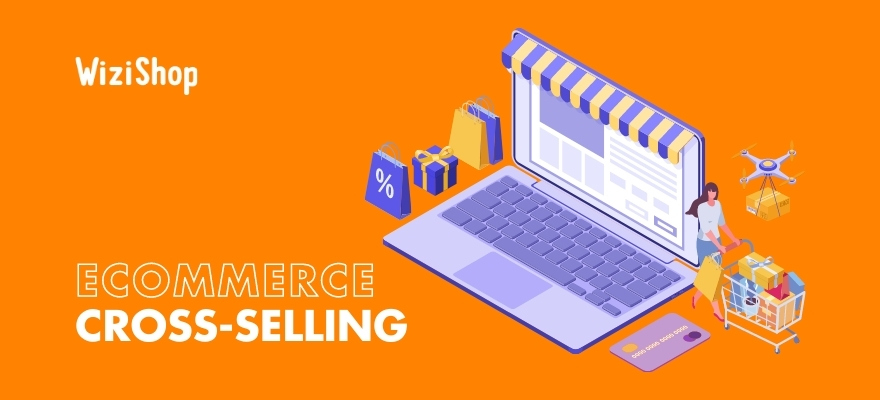To increase the value of your ecommerce business’s shopping carts, several levers are available to you. What are the best solutions, as fast as they are practical?
In the ecommerce sphere, a technique has been widely developed and has become a benchmark: cross-selling.
Just like upselling, cross-selling is very widespread in marketing strategies employed by all kinds of companies, and you’ve likely already been touched by this type of sales technique, almost without realizing it.
Implementing this type of strategy on your online store offers you the opportunity to boost your sales and develop your revenue. But you must master your subject!
That’s why we’re offering you today an overview of cross-selling that you can add in just a few clicks on your WiziShop store!
What does it mean to cross-sell?
Learn more about cross-selling to understand the stakes of cross-selling and set up strategies for your ecommerce business.
Customer relationship management, average cart value increase, additional sales, discounted prices... These elements will bring your store success!
Definition and characteristics
Cross-selling is, by definition, an effective marketing lever that allows you to propose a product that’s complementary to another one so that the customer will add products to their cart.
In a brick-and-mortar store, have you ever noticed that the strawberry aisle is often next to the whipped cream? That in the “bicycle” section, there are pumps for the tires? That in the toys section, there are often lots of batteries?
This is cross-selling: offering recommendations for complementary products that’ll allow you to take full advantage of the initial article, adding great benefits to support its primary use (buying batteries with a toy for children or a pump to reinflate the wheels of your bike: essential associations!)
Cross-selling can also be proposed via the sale of similar products or of the same type (a t-shirt and a pair of pants, a t-shirt in several colors, a t-shirt to go under a jacket, etc.). The field of possibilities is open if the catalog of products you sell allows you to associate many items together!
What’s the difference between cross-selling and upselling?
Be careful! Don’t confuse “cross-selling” and “upselling.” These two sales levers are similar but not the same. So what’s the difference between cross-selling and upselling?
- For cross-selling, it’s about adding an additional item to the initial cart (example: the purchase of a computer + a wireless mouse)
- For upselling, the product initially desired by the user is replaced by another product of greater quality and value, a move upmarket and a higher margin (example: the purchase of a city-dweller car replaced by the acquisition of a state-of-the-art sedan).
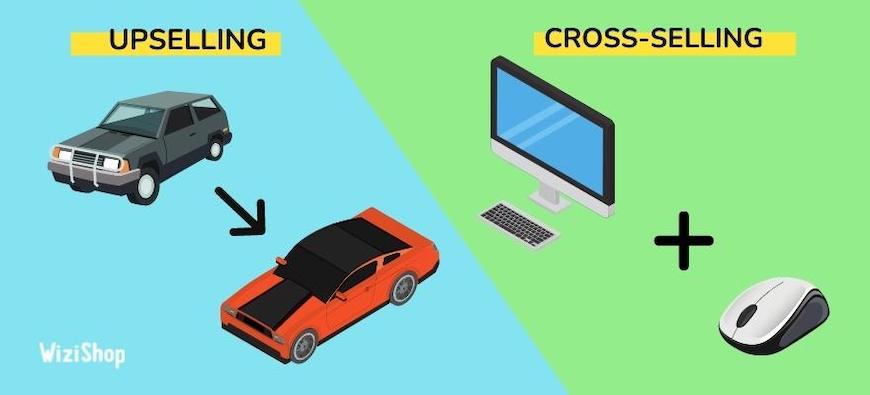
Why is cross-selling a good strategy? What are the benefits?
Cross-selling has many positive points for any salesperson, whether they’re a physical or internet retailer, for digital commerce or ecommerce.
On the web, cross-selling is all the more interesting because the possibilities to install it are even more numerous than in a brick-and-mortar store.
Being able to propose cross-selling on online sales channels means multiplying the chances of increasing the number of items you sell as well as the average order value.
The advantage of this technique on the web is that you can test many possibilities with your product offers. You don’t have to invite visitors to look at complementary products, but you can also promote similar items or even your new products.
You’ll be able to highlight less popular products to attract and retain your customers.
Thanks to the different shopping carts, you’ll be able to precisely analyze your typical clientele in order to better know your prospects.
In addition, your customers will be able to buy several products that you sell at once, which will work to help result in lower shipping costs and a controlled ecological footprint.
If your strategy is well thought out, your average order value is going to be boosted even more!
By choosing the WiziShop solution, the different levers available to make a sale will allow you to optimize your catalog to increase your sales.
As proof, in 2023, the average order value for French shopping sites was €68 compared to €97.32 for WiziShop sellers!
Try WiziShop free for 7 days
THE EASIEST NO-CODE ECOMMERCE SOLUTION✅ No credit card required
✅ Access to all features
✅ No commitment
Cross-selling: Our methods to increase your shopping carts!
To be sure to boost your revenue by choosing to implement a cross-selling strategy, a few tips are necessary, similar to when you wish to avail of upselling techniques.
The golden rule: be relevant while remaining discreet! Make this option a pillar of your action plan.
Choosing the right product
Cross-selling is linked to your customers’ needs. Of course, on your end, you’ll certainly have product stock to sell.
By combining the useful with the enjoyable, you’ll be able to satisfy all parties because the definition of cross-selling is broad and makes it possible to include many commercial ideas while possibly increasing your ecommerce customer retention at the same time.
- One or more complementary products: Offer your customer a total experience between several inseparable products (dishwashing liquid with sponges for example).
- Product associations: Suggest products that are compatible aesthetically or in their uses (several colors or shapes of the same bag, a set of metal straws with a set of glasses, etc.)
- Discoveries of other products that you sell: They may not be directly related to the initial product chosen by the customer but can be presented as commercial opportunities (a flash offer on your end of series, products related to a particular event such as Christmas or Mother’s Day, goodies that can be used by your customers in any situation such as a tote bag, an umbrella, etc.)
- Personalized suggestions: Based on data from your customer’s “wish list” or order history, you can begin offering recommendations for similar items or items that are part of their favorites in order to encourage them to reorder or place an order for their pending items.
The right place, the right time
When would your cross-selling proposal be best received? Is there a quick answer? The answer is no.
Because each technique is unique and specific to each business, it’s very difficult to determine a single method of use to make cross-selling a surefire winning scheme.
The solution will therefore be to test and try out cross-selling associations until you create your own miracle recipe for your company!
But before that, let’s look at some of the locations for cross-selling opportunities favored by a majority of online sellers.
- On product pages: It’s a very simple and common technique to highlight your products directly on other product pages, in a “suggestions” or “recommended for you” section, for example.
- Pop-up during the customer experience: When the visitor moves through some of your pages, why not trigger a “pop-up” window presenting a flash sale product that could entice the potential customer?
- Before confirming the cart: At the level of the filled cart, some sellers offer people product suggestions based on the existing content of the cart, at the bottom. Another location is the pop-up window that appears with a short sale or a promotional offer just before confirming the cart during the checkout process.
Why not consider cross-selling in the long run?
Making your products appear on a page or within a process, a scenario on your site are excellent initiatives.
What if you went even further in selling? What if your products became indispensable to your customers, over time? This is what you can imagine thanks to email or text reminders.
To never lose the connection between your customers and your store, offering your loyal customers the option to add items to their future carts can provide a personalized follow-up that sets you apart. A significant advantage over your competitors!
- By email or text reminder: Your customer bought a product from your store, but this item would have been perfect with another product. When confirming the purchase, or a few days after the customer has received their order, consider sending them a note to thank them, asking if they’re satisfied with their purchase, and if, above all, they’ve forgotten anything! By bringing up the idea that they definitely need this additional product to make the most of the first one they now have, the urgency and the need will be created in the customer who might convert your ecommerce email into a purchase!
- As a “subscription”: If you sell consumable products that have a limited lifespan, calculate the time needed for the product to be unusable. Is it 1 month, 3 months, or 6 months? When the customer places the initial order, program email or text reminders that will be sent automatically at the end of the allotted time to remind your customer to place another order. They may even decide to add one of your new products at that time in addition to their usual order!
- During future visits: By encouraging your existing and potential customers to register and create an account on your ecommerce site, this data will allow you to personalize their future visits in relation to their carts or their wish lists. When the loyal customer connects to your sales site, program personalized recommendations according to this specific customer.
- Retargeting: Advertising on other sites and social networks is a winning lever in the long term. While these paid campaigns will require a small budget, many businesses are going to find that the benefits can be greatly multiplied, towards an optimal conversion rate and greater sales success!
Examples of ingenious cross-selling techniques to boost product sales
Cross-selling is a powerful strategy that businesses use to enhance the customer experience while increasing revenue. By offering complementary products or services during a purchase, companies can provide added value and support to customers. In this section, we explore examples of effective cross-selling strategies, showcasing how different businesses optimize their offers to drive growth.
Chewy: Recommendations on product pages
Chewy, the pet supply website, is a treasure trove for pet owners looking for anything they need to help keep their beloved pets healthy and happy. This online store offers a vast selection of pet food, toys, clothing, medications, and other supplies designed to appeal to a wide range of preferences.
One of Chewy’s distinctive features is its ability to recommend products that go well with the product page you're on. This means that if you're browsing for a particular type of dog food, for instance, the site will recommend other food and treats that are frequently purchased with that food to help you put together the perfect menu for your pup. A very efficient marketing technique!
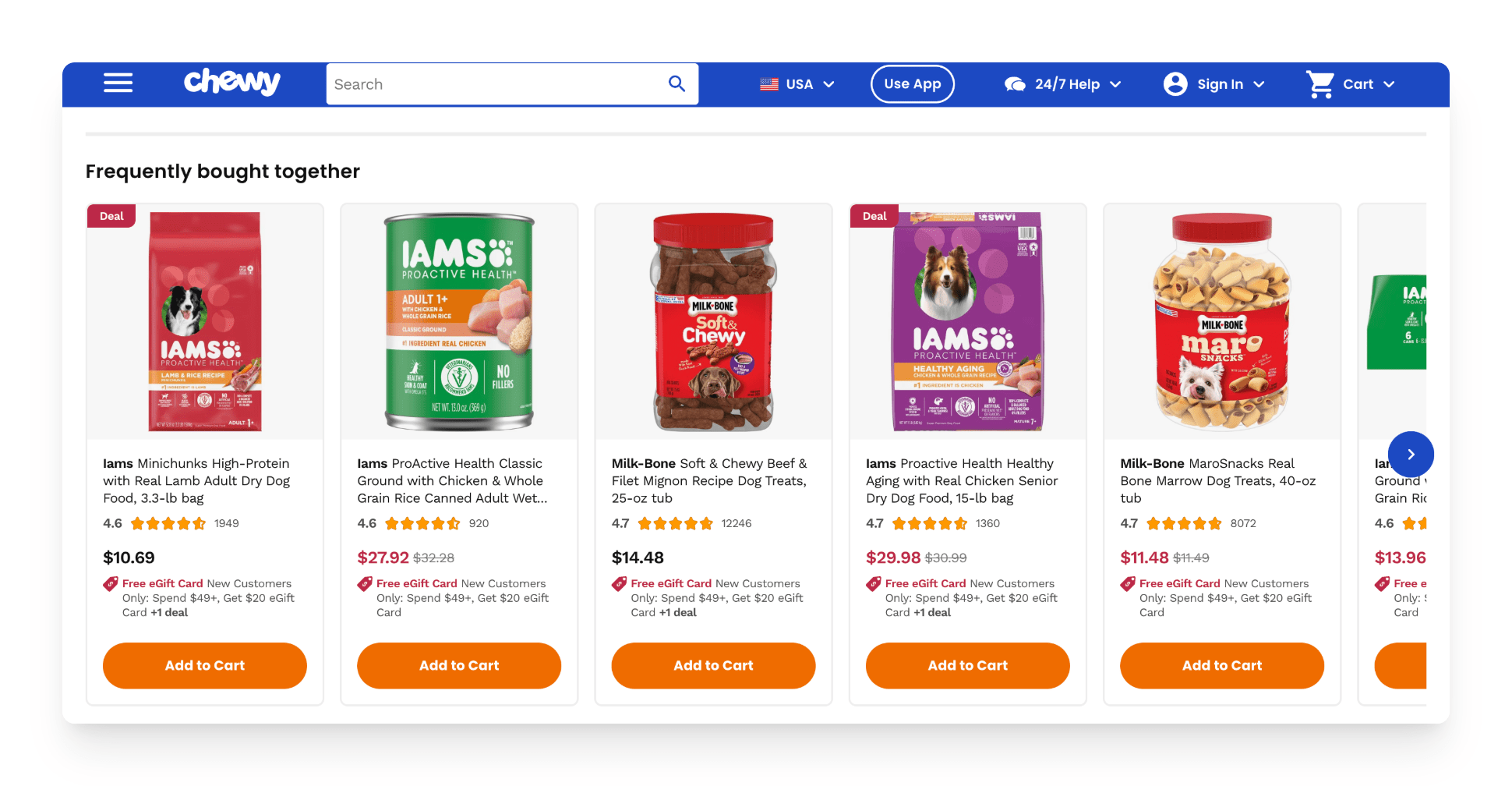
Source: Chewy
Glossier: The tempting presentation
For beauty brand Glossier, the aim here is to encourage shoppers to buy multiple items by highlighting the idea that they’ll save money when they purchase the products in sets rather than individually. And to showcase these sets, the online store has been cleverly designed, displaying the set price along with the price the customer would pay if they were to buy all the items in the bundle separately.
This effective marketing strategy enables the brand to promote its sets while increasing sales of its products. It gives customers the chance to find their favorite products or discover and try new items while saving money on their purchases.
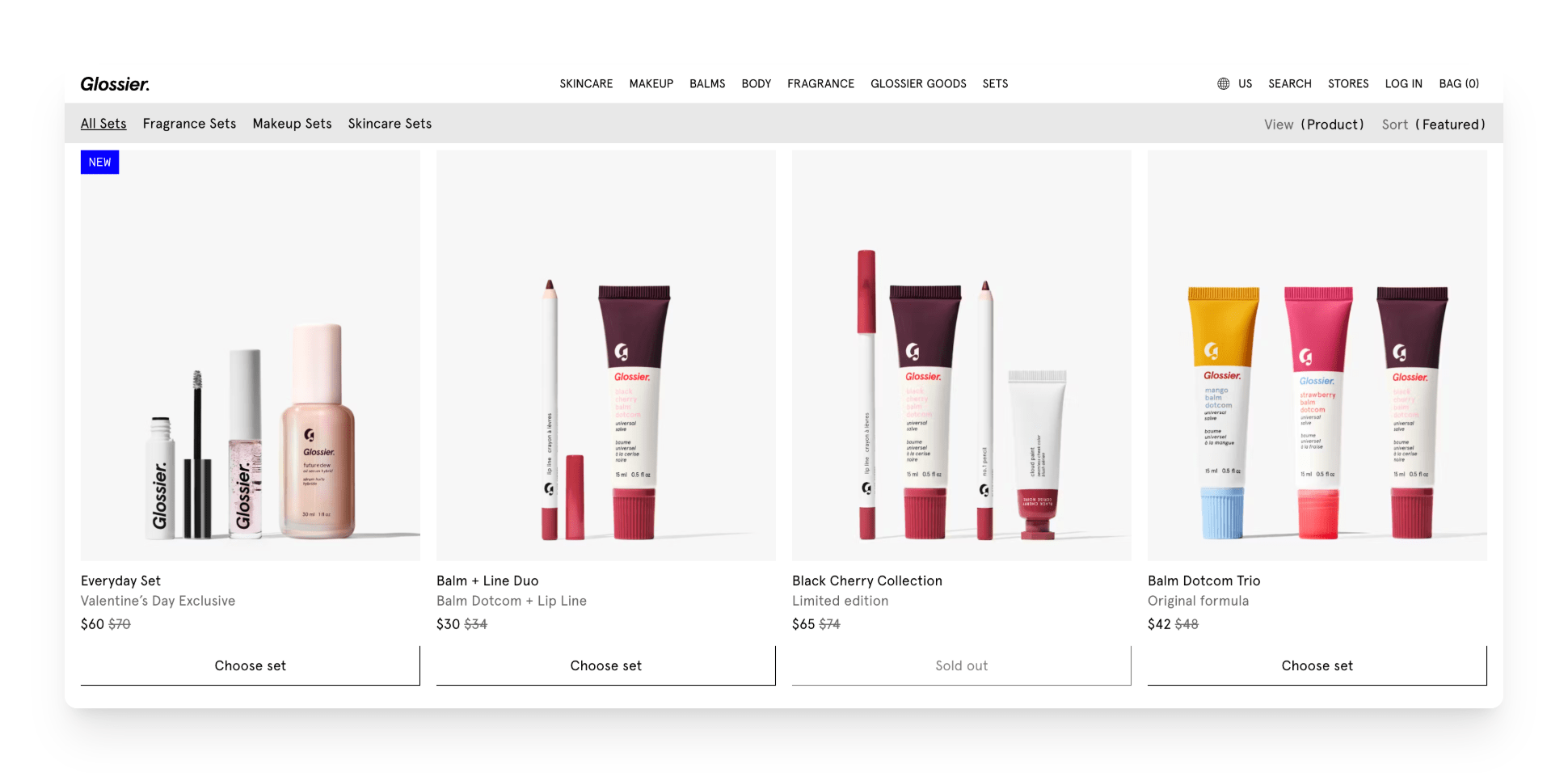
Source: Glossier
Farmacy Beauty: A gift for large shopping carts
Cross-selling also means encouraging customers to increase their order value. How do you do this? By offering them a gift if their shopping cart exceeds a certain amount. This reward can be either a product or a service, like free shipping, for example.
Skincare company Farmacy Beauty currently includes a free 4-piece gift with purchases of $90 or more. Thus, the customer who’s interested in specific products will be tempted to add other products to their existing cart to reach the threshold.
This commercial offer is announced at the beginning of the purchasing process, on the homepage, in order to help encourage as many customers as possible to take advantage of this opportunity throughout their online shopping, also bolstering the customer experience.
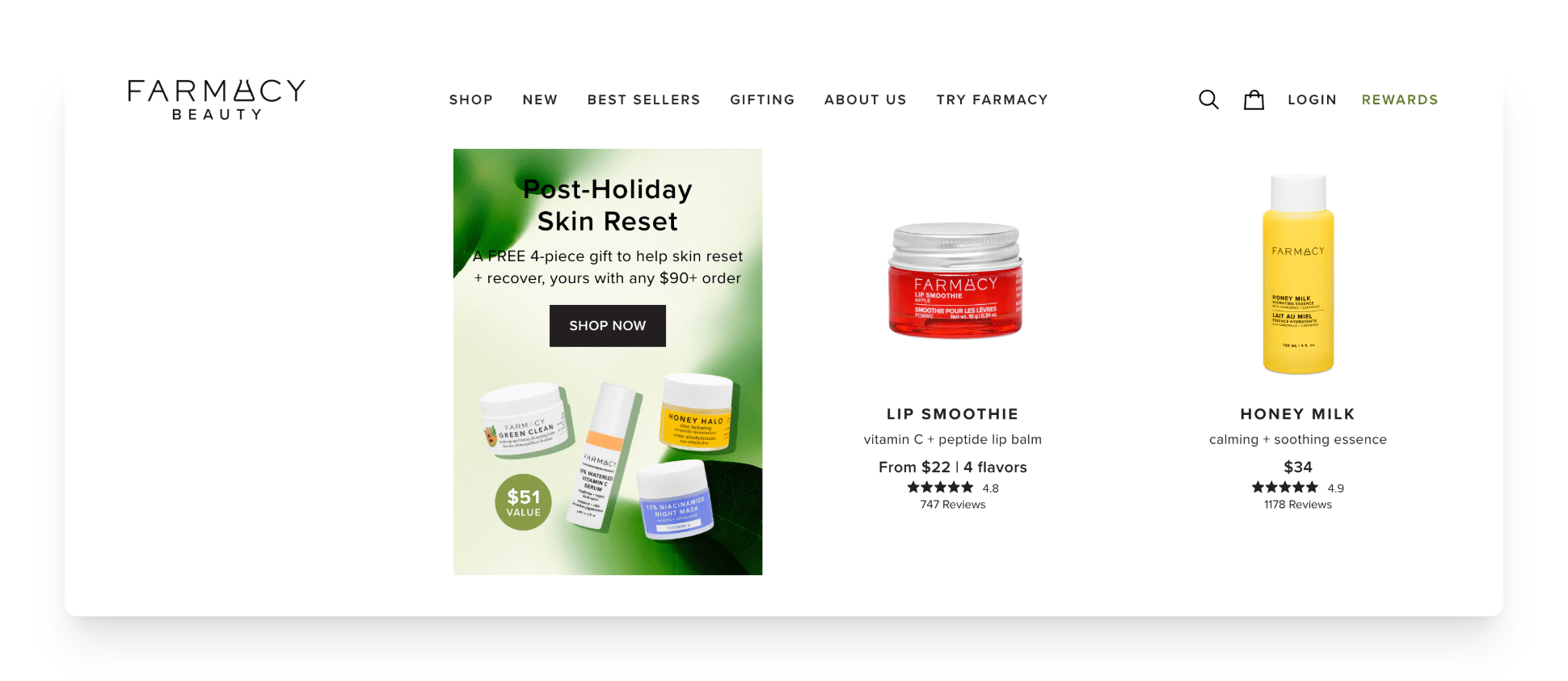
Source: Farmacy Beauty
With these tips and examples of additional offers, you’re now ready to create your own cross-selling offering to best entice customers!
Whatever your business’s pricing strategies, services, or marketing techniques, cross-selling is an effective tactic for your company. Your online store will become a benchmark in terms of customer loyalty. With very few changes and little additional work on your end, your average order value will skyrocket. Ready to boost your sales?


